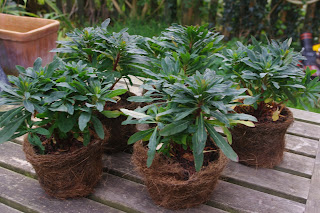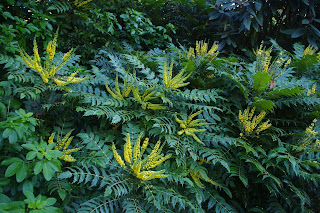A diary of back garden botany, urban ecology, rural rambles and field trips to the middle of nowhere...
Thursday, 30 November 2017
My recent entry about the 'holloways' of Dorset was illustrated with a photograph I took of one such sunken lane several years ago.
I had another look at the batch of photos taken the same day in and around that dank lane. Since childhood I have always had a palpable sense of something primeval in these locales, a sense that nature is an enveloping force.
In the case of the motor car in the last image that is literally the case...
Saturday, 25 November 2017
This is Mistletoe (Viscum album) growing on the trunk of the apple tree. NB It might be helpful to click on the photo to enlarge it to get a good look at it- we have entered the season of low raking sunlight and deep shadows.
'Tis the season or fast approaching but Mistletoe has been associated with plant lore at least as long as its association with Christmas and probably further back than that.
Strictly speaking it is a hemiparasite; it derives nutrition and water from the host tree but photosynthesis takes place as well. Then again this is probably not a point that people give much thought to when they're kissing under a few sprigs of it.
Sunday, 19 November 2017
Sunken lanes can be found all over the country but they are particularly deep and dank in West Dorset. My attention was drawn recently to several articles and essays about these "holloways" as they are sometimes called in that part of the world.
In fact I was not familiar with that name although I have walked along several of the ones I saw mentioned. Some are roads, others no more than tracks, one is arguably a stream bed as much as a pathway!
Their depth is partly the result of many hundreds of years of use and partly the action of water both of which wear down the soft sandstone that is the underlying geology of the area. I must revisit these holloways next year and seek out some that are new to me- Hell Lane near Bridport sounds like a choice location...
Friday, 10 November 2017
Well, we're getting to the time of year when late autumn is heralding the onset of winter. I could be downhearted but it does open up the possibility of walking out to country pubs with log fires, good beer and hearty food.
If you happen to be passing through the village of Preston in Hertfordshire I can recommend the Red Lion for all of those things, set in some nice countryside in the Chilterns. No, I don't have shares in the pub to be recommending it so highly.
Actually the villagers do- it was the first pub in the country to be bought by the community when there were plans to close it down in the 1980s.
Tuesday, 7 November 2017
Traditionally November is getting a bit late to plant things but here in London I think we have in effect a nine month growing season. It's unusual to get a frost until December or even January. Warmer winters seem to be the general trend and this metropolis of millions creates a microclimate of sorts.
So it doesn't seem to be a problem planting the hardier specimens around now. I saw these Euphorbia amygdaloides 'Purpurea' in my local garden centre at half price- too good to miss! 'Purpurea' is a selected form of our native Wood Spurge.
The plant more commonly used in gardens (including this one) is E. amygdaloides var. robbii which has a deserved reputation for being sturdy even in dry shade. Commonly known as 'Mrs. Robb's Bonnet' it's said that the original specimens were bought over from Turkey by a Mrs. Robb in her hatbox.
Friday, 3 November 2017
Spiky, spiny Mahonia species flower late in the year and grow strongly even in deep dry shade. On a sunny day bumblebees will come out of hibernation for the spires of yellow flowers.
Bumblebees are furry so can cope with a certain amount of cold. In fact the greatest number of different bumblebee species are to be found in the Himalayas. For that reason it is speculated that bumblebees evolved in that part of the world. They are predominantly a species of cooler temperate zones. They can be found in hotter climes such as Africa and South America but only in cooler parts eg. mountain ranges.
Subscribe to:
Comments (Atom)













